

Most Human Cells in a Chimera. Ullstein bildGetty Images Scientists have created a human-mouse chimera with 4 percent human cells—the most of any chimera to date.While the embryos showed traces of human cells in most kinds of tissue, including the heart and liver, their germline tissue (which goes on to become sperm or eggs) contained none.Their work was published in the journal Science Advances.
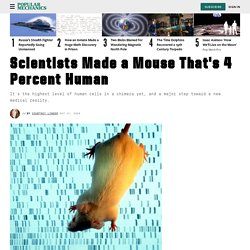
Scientists at the University at Buffalo and the Roswell Park Cancer Institute have bred a new form of human-mouse chimera with the highest incidence of human cells ever recorded. Chimeras are organisms made up of a mixture of genetically different tissues—in this case, mouse cells and human stem cells. The team published its work in the journal Science Advances. Two weeks after the researchers injected human stem cells into the developing mouse embryos, one of the newborn mice exhibited 4 percent human cells—a major advance, considering human and animal cells don't typically jive well. The Case for Making Chimp-Humans.
It is a bit of a stretch, but by no means impossible or even unlikely that a hybrid or a chimera combining a human being and a chimpanzee could be produced in a laboratory.

After all, human and chimp (or bonobo) share, by most estimates, roughly 99 percent of their nuclear DNA. Introducing 'dark DNA' – the phenomenon that could change how we think about evolution. DNA sequencing technology is helping scientists unravel questions that humans have been asking about animals for centuries.
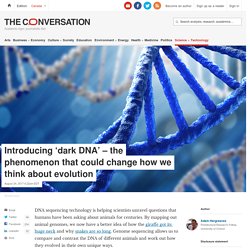
By mapping out animal genomes, we now have a better idea of how the giraffe got its huge neck and why snakes are so long. Genome sequencing allows us to compare and contrast the DNA of different animals and work out how they evolved in their own unique ways. But in some cases we’re faced with a mystery. Some animal genomes seem to be missing certain genes, ones that appear in other similar species and must be present to keep the animals alive.
These apparently missing genes have been dubbed “dark DNA”. The creator of the pig-human chimera keeps proving other scientists wrong. A JOLLA, Calif. — It was the salamanders.
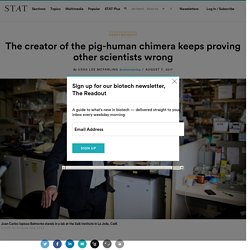
Chinese scientists genetically engineer purple rice rich in antioxidants. Plain white rice is pretty nutritionally empty, so if you want something a little healthier, it's probably worth sticking to other varieties like black or red rice.

But there may soon be another option after Chinese scientists genetically engineered purple rice that is rich in antioxidants and may reduce the risk of cancer and heart disease. The added health benefits of the new rice are thanks to the increased levels of anthocyanins. Not only do these compounds boost antioxidant activity, which is linked to reduced risks of cancer, heart disease and diabetes, they also give foods like blueberries and red grapes their eye-catching coloration.
As a result, the new rice breed has a rich purple pigment. This isn't the first time scientists have tried to engineer rice with higher anthocyanin levels, but efforts hadn't borne fruit due to the complicated biosynthesis pathways involved. Source: South China Agricultural University via Science Daily. Field test of GMO algae sparks outrage. Scientists from the University of California at San Diego and Sapphire Energy released results Thursday from the first open-pond trials of genetically engineered microalgae.

The study, along with research and development of genetically modified (GMO) algae for biofuels, is occurring ahead of adequate regulatory oversight, including the U.S. Environmental Protection Agency’s process to establish and update regulations for genetically engineered algae to protect human health and the environment. Mice Get Freakishly Large Brains Thanks to Human DNA - Motherboard. Scientists Hold Secret Meeting to Consider Creating a Synthetic Human Genome. George Church, a professor of genetics at Harvard Medical School and an organizer of the proposed project, said there had been a misunderstanding.
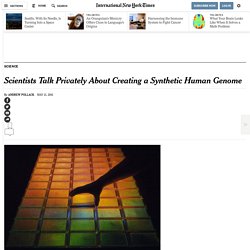
The project was not aimed at creating people, just cells, and would not be restricted to human genomes, he said. Rather it would aim to improve the ability to synthesize DNA in general, which could be applied to various animals, plants and microbes. Genetic editing and the tyranny of opinion - Policy Forum. Dramatic developments in genetic technology have enormous potential for human health, but the heated debate this technology causes goes beyond safety and into moral arguments, writes Russell Blackford.

CRISPR-Cas9 is a dramatic development in genetic technology. It is a powerful, relatively simple, and increasingly precise technique for editing the DNA of living organisms. Its potential application to human beings was highlighted in April 2015, when researchers in China reported their experiments on non-viable human zygotes. The paper by Puping Liang and others was published in the scientific journal Protein & Cell. Gizmodo. Holocaust exposure induced intergenerational effects on FKBP5 methylation - Biological Psychiatry. To view the full text, please login as a subscribed user or purchase a subscription.

Click here to view the full text on ScienceDirect. Figure 1. Earth - Chicken grows face of dinosaur. Sixty-five million years ago, an asteroid is believed to have crashed into Earth.
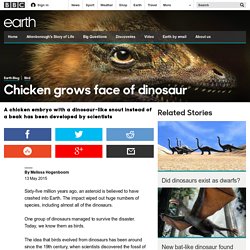
The impact wiped out huge numbers of species, including almost all of the dinosaurs. One group of dinosaurs managed to survive the disaster. Today, we know them as birds. The idea that birds evolved from dinosaurs has been around since the 19th century, when scientists discovered the fossil of an early bird called Archaeopteryx. It had wings and feathers, but it also looked a lot like a dinosaur. But these early birds didn't look the same as modern ones. Scientists Seek Ban on Method of Editing the Human Genome. Photo. Scientists develop biological safety lock for containment of modified organisms. Researchers have developed E. coli bacteria that can't survive without specially-supplied synthetic amino acids (Image: Shutterstock)